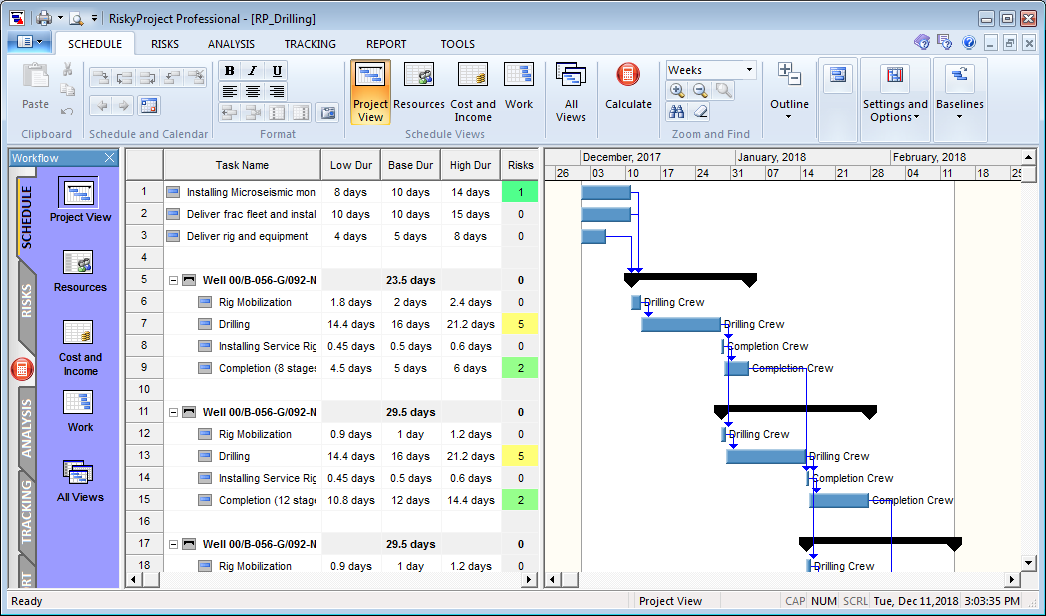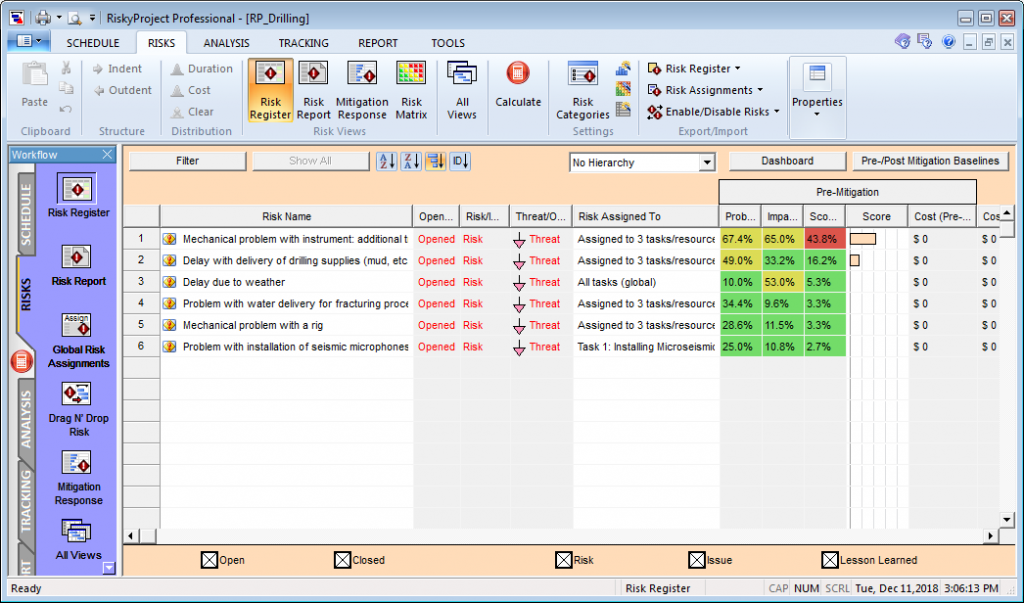Years ago, we worked on team that developed economic and risk analysis software for the oil and gas industry. Like many people we assumed that the energy industry was enormously profitable because of the simple business model that generated large profits selling a product that is an indispensable component of modern society. In fact, what we discovered was that the ROI (return on investment) was relatively modest and generating profits and remaining viable in this industry is extremely difficult. Competition among producers is fierce and finding and extracting fossil fuels is difficult and fraught with obstacles. The modest average ROI that the industry masks an extreme variance where some projects are massively successful while many fail dismally. While there are many factors that can determine the success of failure in this industry, failure to properly manage project risks and by extension control cost and schedule overruns is often a key factor.
Project cost and schedule risk analysis is an important process in the management of energy portfolios. Capital cost represents about 40 of all costs in the portfolios. Risks can significantly increase costs due to project delays and other cost escalations. Cost escalations of more than 30% are common and especially prevalent in new plays where developers have less experience with local conditions. The impact of risks on exploration projects is even higher; therefore, it is extremely important to identify and manage critical risks as part of cost control measures.
Risk impacts to project cost and schedule must be analyzed consistently for all projects in the portfolio and propagate towards corporate portfolio management. Risks can have multiple impacts. For example, a risk could be identified due to a safety concern, so while it will affect safety, it can also impact reputation, cost, and schedule. In addition each project can have multiple risks, each which adds more uncertainty to your project plan.
With multiple risks with multiple impacts, identifying and managing critical or the most important risks is key. Critical risks are those risks which have the most potential to impact key project objectives How much budget and schedule exposure is there due to project risks? Which risks are most critical? How could they affect cost and schedule, and profitability?
This is not to imply that not managing risks is the norm, it isn’t. However, often the method used are inadequate, as the use indirect methods to identify critical risks which are of dubious quality. Qualitative methods are the most subjective and prioritization of risks is unclear as does not take into project schedule and cost models. Traditional quantitative methods model risks indirectly using abstractions such as correlation, which leave the root causes of project uncertainty unclear. It may indicate that a task or group of task have a lot of uncertainty, but is this because of one risk or many and which risk is the most important? In addition, schedule risk is often ignored as a priority as opposed to minimizing cost risk. However, the cliché “Time is money” particularly relevant in this context as time dependent cost risk is often the main driver in cost uncertainty and budget overruns.
The most accurate method for assessing cost risk is to include schedule driven costs or time dependent costs as part of the analysis. This requires resource loaded schedules that include resource rates and allocations. RiskyProject simplifies this process by combining the two major r components of this process: a risk register and project plan. The risk register allows you to identify, assess, manage and control your risks.
The plan includes schedule,costs, and resources. Project activities have durations, start and finish times, lags, costs, and resources. Each one of these activity parameters can be affected by risk.

Project risks are events that potentially could impact your project schedule, cost, or other parameters, but you are unsure if they will occur. Risk are characterized with probabilities of less than 100% but more than 0. In addition, risk impacts must be quantified in terms of cost and time (fixed or relative). The risks are then assigned to each activity.
Once the risk assignment is complete, a Monte Carlo simulation is performed and the results can be used to prioritize your risks and also provide a reasonably accurate assessment of the potential unmanaged impact of each risk to the project. This process allows you to quickly identify cost and schedule uncertainty at both the project and activity level and prioritize risks based on their impact on cost or schedule
The next step is to generate mitigation plans for the most critical risks. These mitigation plans can include multiple activities that have planned finish times, owners, predicted costs, and other properties. Once the risk plans have been approved they can be added into the baseline schedule with associated cost and duration and is considered the post-mitigated baseline The simulation is rerun with planned reductions to the risk probability and impacts due to the mitigation activities and also accounts for the cost of the mitigation plans.

Through this process, we can generate the most accurate quantitative comparison of the pre and post-mitigation costs of the project. Depending upon the goals of the management team, this process can be run multiple times to generate a project plan that meets both the companies cost objectives and risk appetite.

